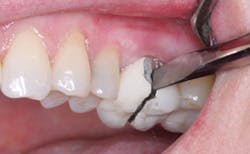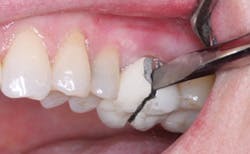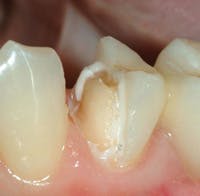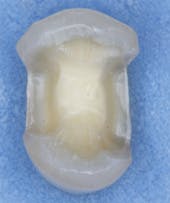Do you need cone beam radiography?
Gordon J. Christensen, DDS, MSD, PhD
Q
I see cone beam radiography promoted in articles and advertised constantly. Is it time to get a cone beam device?
A
The creation of the newest ADA specialty, oral and maxillofacial radiology, and the advent of many cone beam radiography devices on the market have made a significant impact on dentistry. Until a few years ago, the presence of 3-D radiography was relatively unknown and unused in dentistry. Now, dentists are inundated with articles, research, advertisements, and salespeople promoting cone beam radiography.
As I travel around the country and encounter thousands of dentists face-to-face, I feel their frustration and anxiety about whether or not to become involved with this emerging and expensive technology.
Their questions are similar regardless of their geographic location. Among them are:
• What does cone beam offer a typical general dental practitioner? (Fig. 1)
• Would I use cone beam enough to warrant having it available?
• What are the most important advantages of the technology?
• What are the major disadvantages of the technology?
• Is the return on investment worth the purchase price?
• Which is the best device?
• How do the devices differ from one another?
• Is this technology becoming "standard of care"? (Fig. 2)
• Is the technology still in a developing mode, or is it time to purchase?
• Is the radiation exposure high?
I am a prosthodontist who performs both restorative and surgical procedures. I have consulted with oral and maxillofacial specialists during my several years of clinical use of cone beam, and I will share my views combined with some of theirs on this subject.
I have been routinely using cone beam radiology for the indications indicated in this column in my prosthodontics practice for about three years, and we have evaluated several brands of devices in depth in the CR Foundation. However, my real-world practice characteristics allow me to have a relatively unbiased opinion about the usefulness of cone beam. Additionally, I have frequent contact with general practitioners and specialists who have many questions about the technology.
Speaking candidly, many practitioners have an obvious lack of interest in learning this technology. If I speak for more than a few minutes on the topic in continuing education courses, much of the audience loses interest. What are my conclusions after a reasonable period of time evaluating and using the concept?
I will relate my personal experiences integrating cone beam into a prosthodontics practice and evaluating several devices, and answer some of the common questions frequently asked by practitioners.
Uses for cone beam
My observations to date on uses for cone beam radiology in my prosthodontics/restorative/surgical practice have been positive overall, but I'm still waiting for confirmation of the value of this concept for the majority of typical general practices, unless the general practitioner is involved in some of the following techniques.
In my opinion, the procedures listed here are the majority of uses of cone beam radiology in dentistry. They are not listed in any priority:
• 3-D observation of overall oral/facial bony characteristics, allowing easier diagnosis and placement of dental implants
• Surgical guide fabrication for implant placement
• 3-D observation of teeth for endodontic diagnosis and treatment
• Diagnosis and treatment of tooth impactions
• Identification of inferior alveolar nerve and mental foramen location
• Identification of the location of the maxillary sinus
• Identification of the presence of odontogenic lesions
• Trauma evaluation and treatment
• Analysis of temporomandibular joint characteristics leading to diagnosis and treatment
• Integration with CAD/CAM devices for fabrication of prosthodontics or orthodontic appliances
• Identification for referral of numerous conditions or diseases not normally within the realm of dentistry, but that can be shown on typical cone beam images
Strong advocates of cone beam could name numerous, less frequently occurring uses of the technology.
Most general practitioners commonly accomplish only some of the previous procedures. If these procedures are not in someone's repertoire, the value of cone beam is questionable for that practitioner. General dentists have been accomplishing well-defined oral preventive and treatment procedures for decades without cone beam. Does this technology provide adequate improvement for those procedures to warrant incorporating it into general practice? That is debatable. I say yes for some and no for others.
Cost of cone beam devices
The current cost of a cone beam device is high, typically around $100,000. There are some devices that are markedly higher and a few that are lower. That significant amount of financial outlay for the technology should provide some highly desirable characteristics to make it practical for a general practitioner. Dentists should observe their practice habits carefully to see if they routinely perform the procedures that are better accomplished with cone beam, before making the commitment to purchase a device. There are other ways to use cone beam without buying one that I will discuss in this article.
Can cone beam be a cost-efficient service?
When observing the high financial outlay for a cone beam device, prudent practitioners should determine how often they would use the device in their practices. Typical current fees for cone beam imaging in the U.S. range from $150 to $700, and if needed, scans by an oral and maxillofacial radiologist are about $65 to $75. (Personal communication with Dr. Dale Miles, oral and maxillofacial radiologist, on 6-12-12.) It is easy to multiply the number of images anticipated in a typical month of practice by the individual image fees to see if the return on investment is worth the expense. The various fee levels and frequency of use will make this analysis different for each practice. A word of caution related to any high-cost technology - when practitioners have such devices, there is a tendency to overuse them for financial reasons.
Advantages and disadvantages of cone beam
For the uses stated, there is no question that cone beam provides a better potential to improve prevention and treatment of oral diseases and conditions. The disadvantages are also clear. Office space and possibly office remodeling are necessary for installation of the device. The initial cost is high. Learning to use the device and interpret the images requires time, effort, and experience. Office routines are interrupted as the staff and dentist adapt to the new technology and learn the new software. However, when mastered, use of cone beam in the situations described makes it indispensable!
Is there a best device?
What are the desired uses of the device? We have evaluated several brands, and surprisingly, they are not the same. Some make an excellent panoramic image. Some make a great 3-D image. Some do both. One works best with CAD/CAM. Some have excellent service and pre-use education/training; others don't. Some make good and others make poor guided implant placement stents. In other words, you have to identify what you want out of the device and orient your purchase to the strong points of the popular brands. This takes time and consultation with other users, the manufacturer of the device, and the local service people. 3-D radiographic technology has wide differences among devices and is still evolving.
Will this technology become the primary imaging methodology?
In my opinion, this is already taking place. Currently, there are some legal challenges relative to implant failures and the lack of pretreatment cone beam images by the practitioner who placed the implants. How long until cone beam will be required as standard of care is unknown, but it is inevitable for some of the uses described here.
Legal responsibility related to cone beam
Some have said that dentists may be legally challenged when using cone beam radiology, because images of conditions or diseases outside of the normal dental/oral scope of practice may be observed. Those with this opinion apparently don't recognize the in-depth education of dentists, and the professional ethics and clinical responsibility that they demonstrate. Dentists have been making cephalometric images for decades without such challenges. In my opinion over many decades of practice, any health practitioner, regardless of dental or medical specialty, has the responsibility to refer to appropriate specialists any unknown or suspicious condition observed during an examination.
Radiation need for cone beam
The national press has recently challenged the radiation exposure of dental radiographs as being excessive. Although you may have preconceived ideas that such images require significant radiation exposure, such is not the case. Numerous studies have shown that the radiation needed for cone beam radiographs is low when compared to analog dosages.1-8
Should you buy a device?
If you expect only minimal need, no. If you anticipate accomplishing many of the clinical tasks described here, yes. If you expect only minimal need for cone beam, I suggest finding a radiographic clinic in your area that will provide 3-D images at a reasonable fee. Another method for accessing cone beam is available in many geographic locations. Search for mobile radiographic services that may come into your community on request. These mobile services are an easy way to meet the cone beam need without any additional expenditure on your part.
Additional information
During my years of practice, I've noted the many challenges presented by numerous clinical and technological techniques and devices. Among them are the challenges presented with oral radiographic images and devices. As a result, we recently made a second edition of our popular video on clinical failures to avoid.
Summary
This summary is based on research and my personal opinions after routinely using this technology for over three years in a prosthodontics/restorative/surgical practice. Cone beam may or may not be desirable or necessary in your general practice regarding the procedures you perform. If you frequently perform the procedures that will benefit from cone beam use, owning a device can provide adequate return on investment.
The current devices are similar in some ways and very different in others. Seek out the one that best meets your needs. Radiation doses for cone beam are relatively low when compared to analog radiographs. Cone beam is becoming the most desired radiographic method for some procedures in some areas. In my opinion, cone beam is mandatory for many procedures and is one of the most important developments in my long career. Please look into the possibilities for this technology in your own practice, and if needed, find access to it or buy a device yourself or in partnership with some other practitioners.
This one-hour video includes 90 identified potential clinical challenges and failures. It will help you make decisions on those failing techniques and devices and how to avoid them. It is V4757 - "Dr. Christensen's clinical failures and how to avoid them," 2nd edition. You may get information by going to www.pccdental.com or calling 800-223-6569.
References
1. Ludlow JB et al. Dosimetry of 3 CBCT devices for oral and maxillofacial radiology. Dentomaxillofac Rad 2006; 35; 219-226.
2. White SC, Pharoah MJ. Oral Radiology: Principles and Interpretation. 2009. Mosby Elsevier, St. Louis, Missouri.
3. Ludlow JB. A manufacturer's role in reducing the dose of cone beam computed tomography examinations: effect of beam filtration. Dentomaxillofac Radiol. 2011 Feb; 40(2):115-122.
4. Qu XM, Li G, Ludlow JB, Zhang ZY, Ma XC. Effective radiation dose of ProMax 3D cone-beam computerized tomography scanner with different dental protocols. Oral Surg Oral Med Oral Pathol Oral Radiol Endod. 2010 Dec;110(6):770-776.
5. Sur J, Seki K, Koizumi H, Nakajima K, Okano T. Effects of tube current on cone-beam computerized tomography image quality for presurgical implant planning in vitro. Oral Surg Oral Med Oral Pathol Oral Radiol Endod. 2010 Sept;110(3):e29-33.
6. Bianchi A, Muyldermans L, Di Martino M, et al. Facial soft tissue esthetic predictions: validation in craniomaxillofacial surgery with cone beam computed tomography data. J Oral Maxillofac Surg. 2010 Jul;68(7):1471-1479.
7. Silva MA, Wolf U, Heinicke F, et al. Cone-beam computed tomography for routine orthodontic treatment planning: a radiation dose evaluation. Am J Orthod Dentofacial Orthop. 2008 May; 133(5):640.e1-5.
8. Palomo JM, Rao PS, Hans MG. Influence of CBCT exposure conditions on radiation dose. Oral Surg Oral Med Oral Pathol Oral Radiol Endod. 2008 Jun; 105 (6):773-782.
DaVinci Imaging D3D / www.biolase.com
NewTom VGi / www.biolase.com
CS 9300 / www.carestreamdental.com
Gendex GXDP-700 / Gendex Dental Systems / www.gendex.com
VOLUX / Genoray America / www.genorayamerica.com
i-CAT & i-CAT Precise / Imaging Sciences International / www.i-cat.com
Panoura / Image Works Corporation / www.imageworkscorporation.com
Veraviewepocs 3D R100 / J. Morita / www.morita.com/usa
ProMax 3D Mid / Planmeca / www.planmecausa.com
PreXion Elite 3D CBCT/ PreXion / www.prexion.com
SCANORA 3D / Soredex / www.Soredex.com
GALILEOS / Sirona Dental Systems / www.sirona3d.com
Suni 3D Cone Beam System / Suni Medical Imaging / www.suni.com
PaX-Duo3D Plus Cone Beam CT / www.vatechamerica.com
Gordon Christensen, DDS, MSD, PhD, is a practicing prosthodontist in Provo, Utah. He is the founder and director of Practical Clinical Courses, an international continuing-education organization initiated in 1981 for dental professionals. Dr. Christensen is a cofounder (with his wife, Dr. Rella Christensen) and CEO of CLINICIANS REPORT (formerly Clinical Research Associates).



